Back in 2009, three electric motorcycle racing events formed the basis of several years of electric motorcycle racing. I was privileged enough to attend two of the 2009 events, and form a relationship with the TTXGP series that let me attend several years of electric motorcycle racing events in North America and Europe, report on these races as a journalist. Since then the TTXGP, the FIM e-Power series, and the eRoadRacing series which replaced both, have unfortunately ceased to exist and the electric motorcycle racing field has morphed considerably. The majority of electric vehicle racing attention, today, is focused on the FIA’s Formula E, a big money series that appears to be garnering a lot of attention. But the events which began in 2009 made a significant impact on the development of electric motorcycling which will lead to significant adoption of electric motorcycles.
Ted Dillard, who runs the EVMC2 blog, has posted a few “breadcrumb trail” posts the last few days one of which tried to go over the 2009-2010 period of electric motorcycle racing![]() . In that period there’d been one TTXGP event at the Isle of Man during TT Week that gathered a ton of international press coverage, and a second at the AMA’s Vintage Motorcycle Days event at the Mid-Ohio race track. The TTXGP team wanted to take that success to form an international racing series spanning multiple continents, but instead an ugly fight with the FIM ensued and the plans all went kerfluouy. As you read the following ponder what this stream of events might have been if the TTXGP and FIM had managed to work together.
. In that period there’d been one TTXGP event at the Isle of Man during TT Week that gathered a ton of international press coverage, and a second at the AMA’s Vintage Motorcycle Days event at the Mid-Ohio race track. The TTXGP team wanted to take that success to form an international racing series spanning multiple continents, but instead an ugly fight with the FIM ensued and the plans all went kerfluouy. As you read the following ponder what this stream of events might have been if the TTXGP and FIM had managed to work together.
Another thing to ponder is that the TTXGP accomplished all this on a shoestring budget. What could it have done with the sort of budget Formula E has?
What follows is a summary of the TTXGP’s lifetime along with events in closely related series (FIM’s e-Power and eRoadRacing). The story is told using links to my news coverage, because I’d followed these events very closely and managed to write about almost everything which happened. I’m the only person to have attended every TTXGP or e-Power electric motorcycle race in North America. Most of these articles have links to coverage in other venues.
In 2009 the TTXGP electric motorcycle race caught worldwide attention. The organizers hoped to leverage the media attention to launch a longer-term electric motorcycle racing series with races on every continent. It would lead a wave of technology development and demonstrate the power of modern electric vehicles and thereby inspire sweeping change in the motorcycling industry. Unfortunately the result was nowhere near that dream, and the TTXGP is now little more than an asterisk in history.
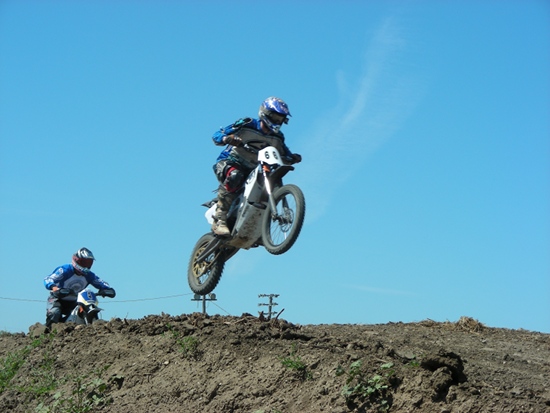 The first electric motorcycle racing event in 2009 wasn’t the TTXGP on the Isle of Man, but the 24 Hours of Electricross organized by Zero Motorcycles. This was the old Zero, while Neal Saiki was still in charge and they hadn’t brought out any street bikes as yet. Basically this was a Motocross 24 hours endurance event (dirt bikes on a dirt track), but with electric motorcycles. I wrote the event up on VisForVoltage back in April 2009
The first electric motorcycle racing event in 2009 wasn’t the TTXGP on the Isle of Man, but the 24 Hours of Electricross organized by Zero Motorcycles. This was the old Zero, while Neal Saiki was still in charge and they hadn’t brought out any street bikes as yet. Basically this was a Motocross 24 hours endurance event (dirt bikes on a dirt track), but with electric motorcycles. I wrote the event up on VisForVoltage back in April 2009![]() . I also shot (and edited) three videos
. I also shot (and edited) three videos![]() , which had been posted on blip.tv but they’ve since been removed. I’ll have to repost them on YouTube because those were good videos.
, which had been posted on blip.tv but they’ve since been removed. I’ll have to repost them on YouTube because those were good videos.
There’d been 10 teams each supplied with one bike and three battery packs and two chargers. The idea was to rotate battery packs, swapping in a new pack every hour or so. Zero’s earlier bikes featured rapidly swappable battery packs – most teams could do the swap in under a minute. Cooling the motors during the pit stop was done by spraying water on the motor casing.
The event captured the attention of several important groups. One was the BlueRibbon Coalition, which I understand has a big interest in people riding off-road vehicles (like dirt bikes). The common complaint is that the noise of typical dirt bikes is obnoxious to those who go to the wilderness to seek peace and quiet. However, the BRC saw electric motorcycles as a way to enjoy off road dirt bike events without the noise.
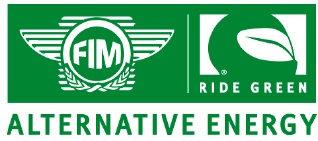 Another was the FIM who wrote up the event in their newsletter focusing on green racing. I don’t see it on FIM’s website, but they used to have an area, FIM Alternate Energy Working Group (AEWG), focusing on developing “green” motorcycle racing concepts. The monthly newsletter mostly discussed ideas like using ethanol fuels – until Zero’s 24 Hours of Electricross and the 2009 TTXGP on the Isle of Man.
Another was the FIM who wrote up the event in their newsletter focusing on green racing. I don’t see it on FIM’s website, but they used to have an area, FIM Alternate Energy Working Group (AEWG), focusing on developing “green” motorcycle racing concepts. The monthly newsletter mostly discussed ideas like using ethanol fuels – until Zero’s 24 Hours of Electricross and the 2009 TTXGP on the Isle of Man.
This TTXGP press release from June 2009 (reposted on VisForVoltage)![]() lists the teams, participants, and some of the development background. The more famous entries in the race – Mission Motors – MotoCzysz – Brammo – were all beaten by the upstart Agni Motors who went with a lightweight bike and dual Agni motors mounted shaft-to-shaft.
lists the teams, participants, and some of the development background. The more famous entries in the race – Mission Motors – MotoCzysz – Brammo – were all beaten by the upstart Agni Motors who went with a lightweight bike and dual Agni motors mounted shaft-to-shaft.
The TTXGP office issued another press release on June 5, 2009![]() , saying that TTXGP 2010 would be even bigger and better. It would have CARS (?? TT Week with Cars??) and multiple classes of electric bikes and fast swappable battery packs allowing a two lap race. Even today, six years later, the TT ZERO (which supplanted the TTXGP) is only a one lap race due to range limitations.
, saying that TTXGP 2010 would be even bigger and better. It would have CARS (?? TT Week with Cars??) and multiple classes of electric bikes and fast swappable battery packs allowing a two lap race. Even today, six years later, the TT ZERO (which supplanted the TTXGP) is only a one lap race due to range limitations.
The hot swappable battery packs may have to do with MotoCzysz’s design for 2009![]() , which featured swappable packs.
, which featured swappable packs.
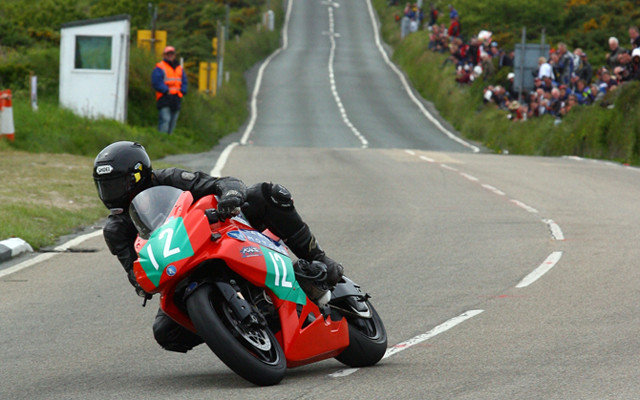 Agni Motors, as I said earlier, won the race
Agni Motors, as I said earlier, won the race ![]() beating out some higher profile better funded teams. That post has links to all the news coverage I could find at the time, including the BBC. A little side note is that Electric Motorsport’s entry was initially disqualified over some rider confusion about when to sound horns under yellow flags. His victory, in the Open Class, was reinstated.
beating out some higher profile better funded teams. That post has links to all the news coverage I could find at the time, including the BBC. A little side note is that Electric Motorsport’s entry was initially disqualified over some rider confusion about when to sound horns under yellow flags. His victory, in the Open Class, was reinstated.
By June 24, 2009 the FIM had announced plans to form a new series for electric motorcycles in 2010![]() . It was to be headed up by Azhar Hussain (TTXGP).
. It was to be headed up by Azhar Hussain (TTXGP).
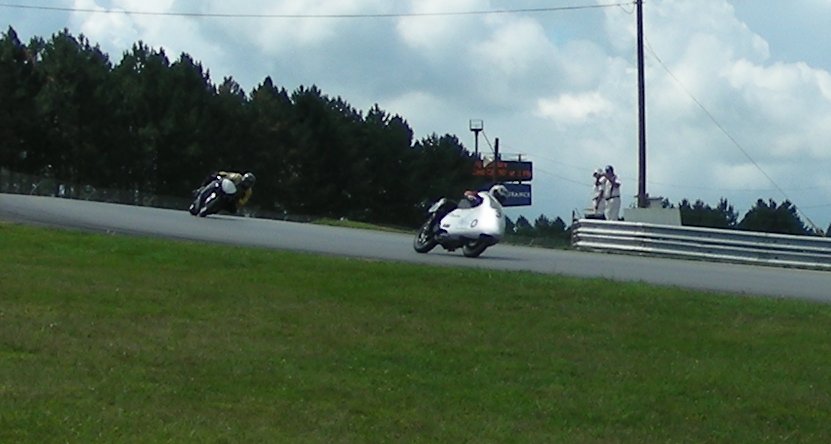 The TTXGP crew had also announced plans to go to AMA’s Vintage Motorcycle Days event at the Mid-Ohio track in late July 2009
The TTXGP crew had also announced plans to go to AMA’s Vintage Motorcycle Days event at the Mid-Ohio track in late July 2009![]() . That event saw participants from around North America, and I was able to attend.
. That event saw participants from around North America, and I was able to attend.
In late August 2009, a series of announcements by TTXGP included rules changes for the 2010 TTXGP on the Isle of Man, the formation of a four-round series in the UK, and plans for a series in the U.S. The agreement with the Auto Cycle Union (UK’s motorcycle racing organization) was finalized by October 6, 2009.
 The 2010 TTXGP technical rules
The 2010 TTXGP technical rules![]() were posted in late October 2009.
were posted in late October 2009.
Lightning Motorcycles did make it to the Bonneville Salt Flats in October 2009. A month earlier Mission Motors had famously gone to a Bonneville event and garnered a lot of attention by setting a 150ish miles/hr land speed record. Lightning beat that record with a 166 miles/hr run, but another team beat them (with a highly specialized bike).
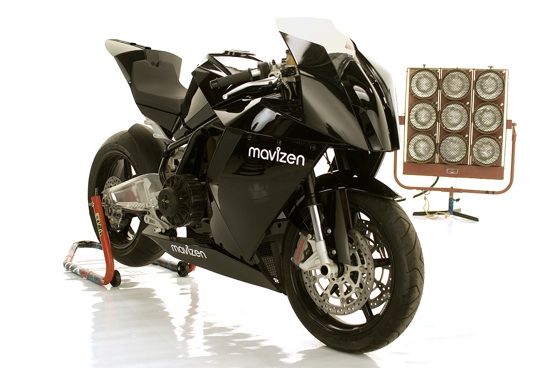 On November 3, 2009, Mavizen unveiled the TTX02, an electric motorcycle based on the Agni Motors design. Agni Motors had been open with other teams showing them how to build the dual-Agni-Motor design, and in 2010 about half the field in both North America and European races used that design. Mavizen’s plan was to supply 50 TTX02’s to electric motorcycle teams in the TTXGP. The design included an embedded Linux computer allowing in-the-field configuration of controller settings, and it was built on the FIM Homologated KTM RC8 which Mavizen got direct from the KTM factory. Top speed was over 130 miles/hr.
On November 3, 2009, Mavizen unveiled the TTX02, an electric motorcycle based on the Agni Motors design. Agni Motors had been open with other teams showing them how to build the dual-Agni-Motor design, and in 2010 about half the field in both North America and European races used that design. Mavizen’s plan was to supply 50 TTX02’s to electric motorcycle teams in the TTXGP. The design included an embedded Linux computer allowing in-the-field configuration of controller settings, and it was built on the FIM Homologated KTM RC8 which Mavizen got direct from the KTM factory. Top speed was over 130 miles/hr.
The most important factoid is that Azhar Hussain owned both Mavizen and the TTXGP.
In November 2009, the TTXGP crew published a DVD of the 2009 TTXGP![]() that covered the race and had interviews with all the riders, as well as on-bike footage. Earlier in the year a “World Premier” event had been held at Mission Motors’ headquarters in San Francisco.
that covered the race and had interviews with all the riders, as well as on-bike footage. Earlier in the year a “World Premier” event had been held at Mission Motors’ headquarters in San Francisco.
At the end of November 2009, FIM announced they would launch the FIM e-Power series to supplant the TTXGP series. (further links on VisForVoltage![]() ) The TTXGP responded saying they were disappointed, and that “despite our best efforts over many months to establish a truly inclusive world series, the FIM has decided to launch one independently of TTXGP.”
) The TTXGP responded saying they were disappointed, and that “despite our best efforts over many months to establish a truly inclusive world series, the FIM has decided to launch one independently of TTXGP.”
On December 1, 2009, I wrote a post asking whether the FIM was attempting to “steal” electric motorcycle racing from TTXGP. Writing on Hell For Leather, Ivar Kvadsheim laid out the timeline and made the case that FIM had “wronged” TTXGP. He claimed that FIM didn’t have enough expertise with electric racing to develop their own rules, and that FIM appropriated rules that had largely been written by the TTXGP. I should note at this point that, a couple years later, through several conversations with Charles Hennekam of the FIM, I was informed that electric motorcycle races had occurred under FIM auspices going back perhaps 20 years and that the FIM had existing electric motorcycle rules.
Getting back to my December 1 post, it also summarized a post by Jensen Beeler (Asphalt and Rubber) suggesting a possible motive. Because Azhar Hussain controlled both TTXGP and Mavizen, there was obviously a potential conflict of interest. Obviously Hussain could have tilted the playing field to favor Mavizen’s bikes. This allegation was never quelled over the years. While I don’t know of any concrete evidence that TTXGP played any kind of favoritism, many TTXGP participants over the years returned to this sort of allegation.
Prior to the November 3 announcement I’d been briefed over the phone by Azhar Hussain about Mavizen’s plans. The potential conflict of interest was obvious even during that phone call, so I asked him about it. He replied that Mavizen’s purpose wasn’t to compete with other suppliers but to jumpstart the TTXGP competition. To launch a series, Hussain knew he had to “fill the grid” (have enough teams to stage credible races and keep fans interested). Hence, some organization had to step up to the plate and deliver some bikes which could be raced.
December 1, 2009, SWIGZ.COM (Chip Yates), CRP and Zero Motorcycles all announced they would participate in the TTXGP. Chip Yates was an AMA Pro racer who’d been laid up in the hospital with a broken hip when the 2009 TTXGP occurred. He was intrigued, and planned out the design of what he though a proper electric superbike would be. CRP is an international technology company based in Italy, who has experience providing technology into several racing series (and other areas). Zero Motorcycles said they would modify a 2010 Zero S, their new street bike, for TTXGP racing. (this post includes links to several sources)
January 3, 2010 I posted a summary of a dozen or so announcements![]() : (an extensive list of links is in the post)
: (an extensive list of links is in the post)
Nov 26, 2009 – Dates for all TTXGP championship races in the UK were confirmed. Also confirmed was the first race of the 2010 season, held from May 14-16 at the Infineon racetrack near San Francisco.
December 1, 2009 – Zero Motorcycles announces their entry into the TTXGP 2010 races. Interestingly while Zero builds their own electric motorcycle they plan to use a Mavizen bike in the race, but the race bike will be powered by Zero’s Z-Force battery packs and motors.
Dec 3, 2009 – TTXGP indicates it has received commitments from Zero Motorcycles, Mission Motors and CRP Racing to compete in the TTXGP racing series. Both Mission Motors and CRP Racing have made an exclusive commitment, while Zero Motorcycles hasn’t committed to an exclusive arrangement.
Dec 14, 2009 – Mosport International, Toronto will hold Canada’s first TTXGP race in July 2010 and is round 2 of the TTXGP North American Championship 2010. Round 1 of TTXGP North America is the Infineon race noted above.
Dec 15, 2009 – Not content to rest on electric motorcycle laurels, the TTXGP team announced the launch of an electric car racing series named the EMXGP. Not much is known about the EMXGP but no doubt the TTXGP/eGrandPrix team will in short order reveal more information about this race. What’s known is the first event is scheduled for June 4-6 near Paris France.
Dec 15, 2009 – The TTXGP announces the grand final race in the 2010 series will be held in October at Albacete, Spain. This is in partnership with the European Motorcycle Union (UEM), a racing organization which unifies 47 member countries and is the largest Continental Union for motorcycling in the world and the largest partner of the FIM.
Dec 15, 2009 – The TTXGP announced the fourth and final event in the UK championship 2010 series will be held at Brands Hatch, 2-3 October. They also state the highest placed teams from the TTXGP series 2010 will compete in a grand final in October in Albacete, Spain in conjunction with the European Motorcycle Union (UEM).
Dec 15, 2009 – The third venue for the TTXGP North America 2010 series is announced to be at VIRginia International Raceway (pictured) 13 – 15 August. This will be part of the AMA Pro Superbike Championship.
Dec 17, 2009 – Electric Motorsport announces they will participate in TTXGP races during 2010. Electric Motorsport won the Open Class in 2009. Todd Kollin, EMS President, said, “The TTXGP is going to get real competitive this upcoming year. Electric Motorcycles still have a lot to prove on and off the track. Such competition will really spur innovation and technology in the EV industry, pushing the limits of what is possible.” They have not announced exclusivity for the TTXGP however their “level of involvement is directly related to the level of team sponsorship we can solidify”.
Dec 17, 2009 – On Brammofan’s blog is an announcement that Team AGNI will be racing two bikes at the Isle of Man in 2010, and that the second bike will be ridden by Jenny Tinmouth now owns the fastest women’s lap record for the Isle of Man. Unfortunately Team AGNI’s website doesn’t have confirmation.
Dec 18, 2009 – TTXGP announces there will be four races scheduled in Italy during 2010. The races in Italy are slated for Magione on June 27, Franciacorta on July 25 and September 5 and Mugello on September 26. The race series is sanctioned by the Federazione Motociclistica Italiana.
Dec 18, 2009 – Brammofan announces on his blog a pair of maps (maintained via Google Maps) showing the known TTXGP and FIM races in 2010.
Dec 19, 2009 – FIM announced additional dates where electric motorcycles would ride during two already scheduled MotoGP and WorldSuperbike races. These two race series have more visibility than does the TT which may give FIM based race series more visibility than the race series the TTXGP organization is assembling.
Dec 27, 2009 – The TORK INDIA team posted a picture of a covered motorcycle on their facebook account page. No explanation but presumably it’s a teaser of the bike they intend to race during 2010. In private communication they indicated they would “surely confirm our interest shortly” as to which race series they would participate in, and “For now we have no confirmed plans.”
@Brammofan, a.k.a. @emotorules, was the Twitter handle for Harry Mallin. By day he’s a Government Lawyer, but by night he was crusading for electric motorcycles. He worked closely with the TTXGP team on several projects.
January 8, 2010, Roehr Motorcycles reiterated a promise to race an electric motorcycle in the 2010 North America TTXGP![]() . They eventually never showed up for anything. On January 18, 666 Racing had made a similar announcement
. They eventually never showed up for anything. On January 18, 666 Racing had made a similar announcement![]() but instead of coming with their own motorcycle (like Roehr) 666 would be racing with a Mavizen TTX02. Like Roehr, 666 Racing never showed up to any event.
but instead of coming with their own motorcycle (like Roehr) 666 would be racing with a Mavizen TTX02. Like Roehr, 666 Racing never showed up to any event.
January 29, 2010, the Isle of Man Department of Tourism and Leisure announced![]() that the DTL would take over the electric race series during TT Week, and that it would not be run by the TTXGP. The replacement series would be called TT ZERO. Azhar Hussain said “The TTXGP race last year was a huge successes. We’ve put in a lot of effort and hard work to make the 2010 race even better, and are disappointed the Isle of Man TT has decided not to work with us this year. This is the Isle of Man TT’s decision, so you would have to ask them. We’ve done everything we could to make the Isle of Man TTXGP happen.”
that the DTL would take over the electric race series during TT Week, and that it would not be run by the TTXGP. The replacement series would be called TT ZERO. Azhar Hussain said “The TTXGP race last year was a huge successes. We’ve put in a lot of effort and hard work to make the 2010 race even better, and are disappointed the Isle of Man TT has decided not to work with us this year. This is the Isle of Man TT’s decision, so you would have to ask them. We’ve done everything we could to make the Isle of Man TTXGP happen.”
With this the schism in electric motorcycle racing was:
- TTXGP with series planned for United Kingdom, Italy and North America (the Italian series eventually never happened, but a Europe series did happen)
- FIM e-Power with events scheduled at FIM’s events like MotoGP and World Superbike
- TT ZERO by the Isle of Man
February 9, 2010, I wrote a post suggesting that TTXGP had much more momentum than either FIM’s e-Power or the newly minted TT ZERO.![]() It started by summarizing a followup statement by the Isle of Man Government
It started by summarizing a followup statement by the Isle of Man Government![]() in response to “the speculation and unsubstantiated claims” about the decision to run the TT Zero rather than TTXGP race during the yearly TT Week events. Supposedly the problem was that the TTXGP had plans to run an electric car race, the EMXGP, in Paris in June 2010 at a time which would conflict with their participation with TT Week on the Isle of Man. Azhar Hussain denied this was the problem, but didn’t describe what the problem actually was. This post went on to note that more teams had announced intention to race with TTXGP than with the other two series.
in response to “the speculation and unsubstantiated claims” about the decision to run the TT Zero rather than TTXGP race during the yearly TT Week events. Supposedly the problem was that the TTXGP had plans to run an electric car race, the EMXGP, in Paris in June 2010 at a time which would conflict with their participation with TT Week on the Isle of Man. Azhar Hussain denied this was the problem, but didn’t describe what the problem actually was. This post went on to note that more teams had announced intention to race with TTXGP than with the other two series.
In January I’d polled the teams I could identify as to their intentions![]() .
.
March 1, 2010, Agni Motors announced they’d race in all three of the TTXGP series![]() . (UK, Italy, North America)
. (UK, Italy, North America)
March 16, 2010, TTXGP announced a plan where teams participating in TTXGP races would effectively co-own the racing series![]() . Supposedly. The rules were published on a Wiki where any participant could collaboratively work on improving the rules. Teams racing in TTXGP events would earn “units” of ownership, and a pool of earnings would be shared out to the teams. “Pioneer Units” would be given to teams racing exclusively with the TTXGP in the 2010, 2011 and 2012 seasons.
. Supposedly. The rules were published on a Wiki where any participant could collaboratively work on improving the rules. Teams racing in TTXGP events would earn “units” of ownership, and a pool of earnings would be shared out to the teams. “Pioneer Units” would be given to teams racing exclusively with the TTXGP in the 2010, 2011 and 2012 seasons.
Earlier some news outlets noted that FIM was giving a 5000 euro bonus to any team that would race in FIM’s e-Power series![]() .
.
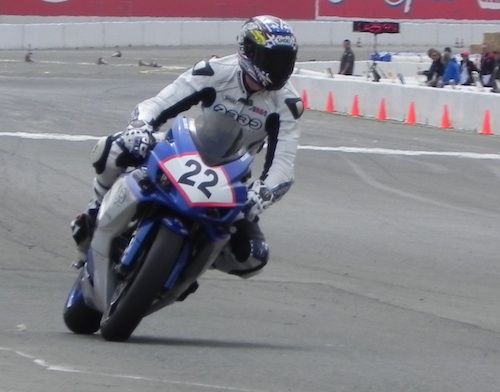 May 15, 2010, the first TTXGP event of the 2010 season was at Infineon Raceway
May 15, 2010, the first TTXGP event of the 2010 season was at Infineon Raceway![]() (a.k.a. Sears Point a.k.a. Sonoma Raceway) during the AMA weekend. This race received LOTS of press attention, especially from outlets (like Wired.com) that never report on racing. There was a large field with 12+ teams from all over North America
(a.k.a. Sears Point a.k.a. Sonoma Raceway) during the AMA weekend. This race received LOTS of press attention, especially from outlets (like Wired.com) that never report on racing. There was a large field with 12+ teams from all over North America![]() . The Agni Motors bike (the same bike that won the 2009 TTXGP) won at Infineon
. The Agni Motors bike (the same bike that won the 2009 TTXGP) won at Infineon![]() , beating out Lightning Motors. The problem was that about 2/3rds of the way through the race, the Lightning bike developed a glitch and the rider had to sit at the side of the track for about 40 seconds trying to reboot the bike before he could take off again.
, beating out Lightning Motors. The problem was that about 2/3rds of the way through the race, the Lightning bike developed a glitch and the rider had to sit at the side of the track for about 40 seconds trying to reboot the bike before he could take off again.
June 3, 2010, I summarized what had happened with the two FIM e-Power races which had run so far![]() . The first of those was described as a flop, and neither were much of an event. Ivar Kvadsheim had reported that one issue between FIM and TTXGP was that FIM demanded TTXGP guarantee at least 15 teams per race. However, both of the e-Power races until that point had only 6 teams show up, with several denied entry on the racing grid. Further the teams were racing in “eco mode” to preserve energy so they could finish the race.
. The first of those was described as a flop, and neither were much of an event. Ivar Kvadsheim had reported that one issue between FIM and TTXGP was that FIM demanded TTXGP guarantee at least 15 teams per race. However, both of the e-Power races until that point had only 6 teams show up, with several denied entry on the racing grid. Further the teams were racing in “eco mode” to preserve energy so they could finish the race.
 June 4, 2010, the TTXGP raced at the Road America track in Wisconsin
June 4, 2010, the TTXGP raced at the Road America track in Wisconsin![]() . The Agni bike was simply run by Agni Motors, not in collaboration with Zero Motorcycles. There was a little bit of shake-up of the teams, with some teams not making the trek to Wisconsin. Lightning Motors won this race
. The Agni bike was simply run by Agni Motors, not in collaboration with Zero Motorcycles. There was a little bit of shake-up of the teams, with some teams not making the trek to Wisconsin. Lightning Motors won this race![]() settling into a pattern where, because their bike was so much faster than all the others, they’d lap the entire field at least once making everyone else look like they’re standing still.
settling into a pattern where, because their bike was so much faster than all the others, they’d lap the entire field at least once making everyone else look like they’re standing still.
Lightning’s 2010 bike is the one with the unobtanium GM EV1 motor — the nameplate clearly said “General Motors” and the serial number made it clear the motor had been in one of the EV1’s which GM had crushed after being recalled from an EV1 owner. It’s their 2011 and later bikes which were the direct predecessor of the Lightning LS-218 which went on sale in the Fall of 2014.
June 10, 2010, Mark Miller (MotoCzysz) wins the 2010 TT ZERO at Isle of Man![]() . This set a pattern where MotoCzysz won every TT ZERO it entered, even beating Mugen a couple years. Lap speed was 96 miles/hr, not enough to break the ton.
. This set a pattern where MotoCzysz won every TT ZERO it entered, even beating Mugen a couple years. Lap speed was 96 miles/hr, not enough to break the ton.
June 16, 2010, TTXGP posted new dates for the TTXGP UK and TTXGP Italy race series. The Italian series was to be running in August/September 2010, and the UK series in July, August and October. The world final was to be held in late October, at Albacete Spain.
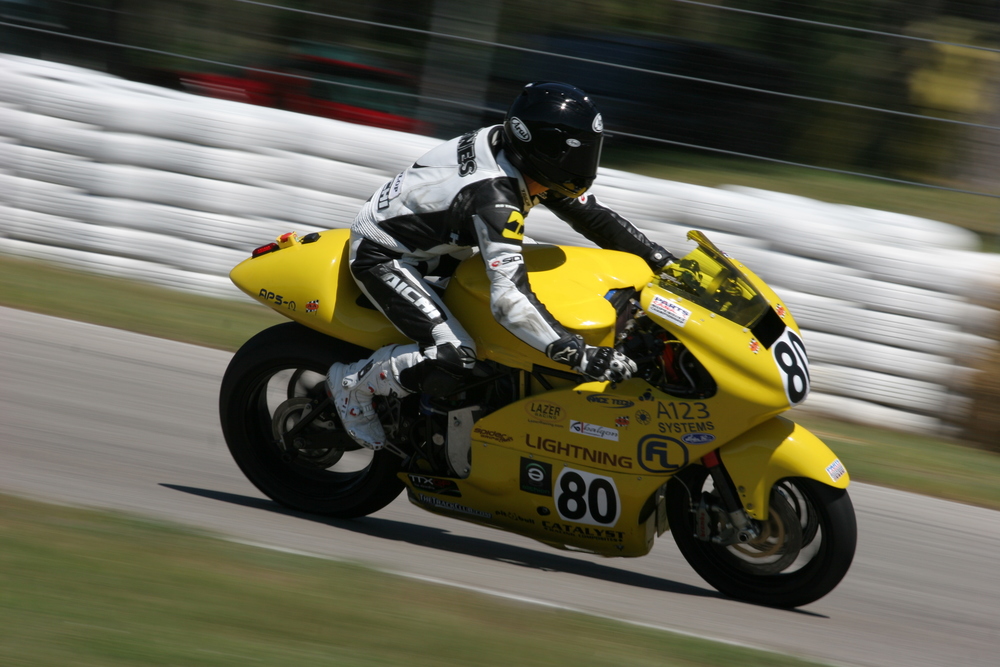 July 10, 2010, the TTXGP raced at Mosport Raceway (outside Toronto, Canada)
July 10, 2010, the TTXGP raced at Mosport Raceway (outside Toronto, Canada)![]() . Lightning Motors won
. Lightning Motors won![]() . The same weekend the UK series got underway at Snetterton
. The same weekend the UK series got underway at Snetterton![]() .
.
July 16, 2010, Roehr announced a ready-to-race electric superbike with dual AC motors![]() . Top speed around 135 miles/hr.
. Top speed around 135 miles/hr.
July 19, 2010, Brammo made their initial announcement of the Empulse![]() . This is the version which predated the decision to put a gearbox on the Empulse. Top speed around 100 miles/hr.
. This is the version which predated the decision to put a gearbox on the Empulse. Top speed around 100 miles/hr.
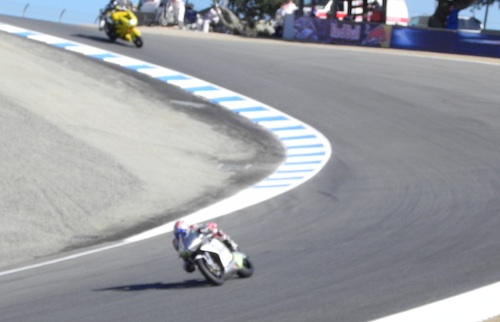 July 25, 2010, the FIM e-Power series came to America in conjunction with the MotoGP at the Laguna Seca International Raceway
July 25, 2010, the FIM e-Power series came to America in conjunction with the MotoGP at the Laguna Seca International Raceway![]() . A pattern is established at this race where MotoCzysz beat Lightning Motors by a nose. It was wise energy management by Michael Czysz, to hold back most of the race and let Michael Barnes burn up the juice on the bike, then make a final sprint to the finish line.
. A pattern is established at this race where MotoCzysz beat Lightning Motors by a nose. It was wise energy management by Michael Czysz, to hold back most of the race and let Michael Barnes burn up the juice on the bike, then make a final sprint to the finish line.
Brammo’s plan had been to race the Empulse at this event, but they were unable to do so. Brian Wisman claimed it was his fault, that he’d broken the bike. That rendered the Empulse a pretty looking sculpture in their paddock, but which didn’t stop them from showing the bike off and talking to customers.
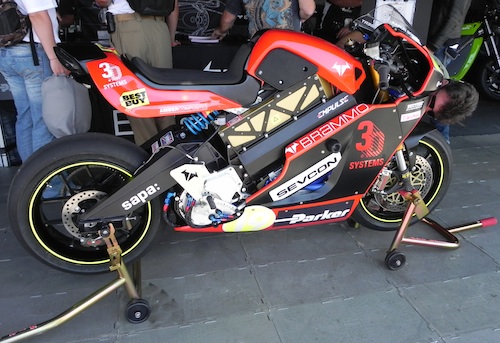 This was an FIM-only event. The existing e-Power teams were all from Europe, and were flown at FIM expense to California. Additionally most of the TTXGP teams participated, as e-Power teams. In subsequent years the Laguna Seca event was a joint e-Power/TTXGP event except for the 2013 instance which was the one year of eRoadRacing’s existence.
This was an FIM-only event. The existing e-Power teams were all from Europe, and were flown at FIM expense to California. Additionally most of the TTXGP teams participated, as e-Power teams. In subsequent years the Laguna Seca event was a joint e-Power/TTXGP event except for the 2013 instance which was the one year of eRoadRacing’s existence.
July 29, 2010, I wrote a piece discussing how the teams at both TTXGP and e-Power races I’d attended were cooperating with each other to help each other fix each others bikes![]() . The feeling in the 2010 paddock (North America) was comradeship, where we were all working together on the common goal of establishing electric motorcycle racing. This feeling was lost as the years wore on, however.
. The feeling in the 2010 paddock (North America) was comradeship, where we were all working together on the common goal of establishing electric motorcycle racing. This feeling was lost as the years wore on, however.
August 5, 2010, Quantya had been working on a plan to set up an electric-only off-road dirt bike track in the English countryside![]() . However the locals were afraid of the noise pollution that would result, and were opposing the plan. We think they don’t grasp the notion of electric motorcycles being quiet, and therefore no noise pollution.
. However the locals were afraid of the noise pollution that would result, and were opposing the plan. We think they don’t grasp the notion of electric motorcycles being quiet, and therefore no noise pollution.
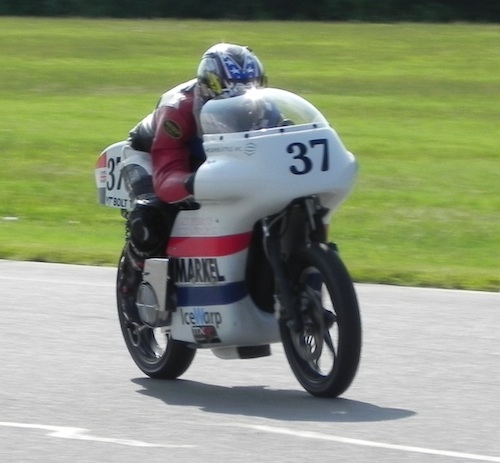 August 16, 2010, TTXGP’s North American final occurs at VIRginia International Raceway
August 16, 2010, TTXGP’s North American final occurs at VIRginia International Raceway![]() . Lightning Motors won the race and the North America crown.
. Lightning Motors won the race and the North America crown.
August 27, 2010, the TTXGP Italy series was canceled and replaced by a TTXGP Europe series the first of which would be at Assen![]() . There’d been a lot of doubt over several months about the Italian series, but it was unclear why it didn’t happen.
. There’d been a lot of doubt over several months about the Italian series, but it was unclear why it didn’t happen.
August 29, 2010, Chip Yates announced he’d be unveiling his electric superbike at The Battery Show in San Jose CA in October![]() .
.
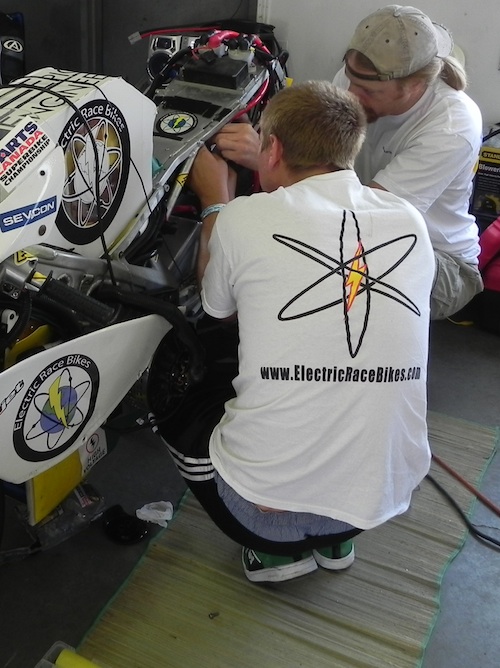 September 1, 2010, Matt Dieckmann, the leader of ElectricRaceBikes.com (a TTXGP North America team) died in a traffic accident while riding a prototype electric motorcycle
September 1, 2010, Matt Dieckmann, the leader of ElectricRaceBikes.com (a TTXGP North America team) died in a traffic accident while riding a prototype electric motorcycle![]() . A car pulled in front of him and he had no time to avoid a collision.
. A car pulled in front of him and he had no time to avoid a collision.
He was a young man with huge ideas about electric motorcycle design and building a little business selling parts for DIY electric motorcycle construction. He had built several different designs, and had some interesting ideas in mind for the 2011 season.
September 2, 2010, Lightning Motorcycles ups the electric motorcycle land speed record to 176 miles/hr![]() . MotoCzysz was also present, but Lightning handily set the higher land speed record.
. MotoCzysz was also present, but Lightning handily set the higher land speed record.
 October 5, 2010, The TTXGP UK and TTXGP Europe series concluded in a joint race at Brands Hatch
October 5, 2010, The TTXGP UK and TTXGP Europe series concluded in a joint race at Brands Hatch![]() . The Europe series included several teams that were of long lasting importance over the subsequent years:
. The Europe series included several teams that were of long lasting importance over the subsequent years:
- eCRP Racing – the outgrowth of the CRP electric superbike announcement referenced earlier. The eCRP version 1.2 used the twin-Agni motor design. At the Albacete race they had two eCRP 1.2’s in action.
- Meunch Racing – A German team led by Matthias Himmelman and Thomas Schuricht. Their bikes were built using AC motors acquired from Siemens.
- Zongshen Racing – In this season they were riding a motorcycle provided by Agni Motors, specifically the same bike Agni had run at the 2009 TTXGP and in North America during the 2010 series. That bike had been shipped back to Europe, and given a Zongshen specific coat of paint.
Another team in TTXGP Europe, SPA Francorchamps, came from a motorcycle racing institute in Belgium. They had earlier announced plans to hold classes to teach people how to build electric racing motorcycles. They, too, used the twin-Agni design, and then only stayed with TTXGP for the 2010 season.
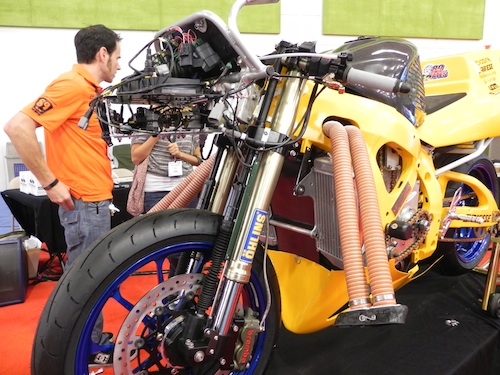 October 6, 2010, Chip Yates displays his electric superbike at The Battery Show
October 6, 2010, Chip Yates displays his electric superbike at The Battery Show![]() , and I was able to go to that show and meet him. The bike shown at that time had mechanical linkages from the front wheel, through the frame, allowing Yates to engage the front wheel to the drive motor as a mechanical regenerative braking system. Typically regenerative braking on a motorcycle is done through the rear wheel, Yates wanted it off the front wheel. Between the extra large electric motor (from UQM) and controller, and the mechanical linkages, there was no room in the middle of the bike for the battery pack, and instead the pack was on the tail.
, and I was able to go to that show and meet him. The bike shown at that time had mechanical linkages from the front wheel, through the frame, allowing Yates to engage the front wheel to the drive motor as a mechanical regenerative braking system. Typically regenerative braking on a motorcycle is done through the rear wheel, Yates wanted it off the front wheel. Between the extra large electric motor (from UQM) and controller, and the mechanical linkages, there was no room in the middle of the bike for the battery pack, and instead the pack was on the tail.
October 13, 2010, Team Electra became the first known electric motorcycle team to enter a gas bike race and win![]() . Team Electra had participated in the 2009 TTXGP event at Mid-Ohio, then in the full 2010 North America season. Their motorcycle was a historic Norton Featherbed frame that had been kitted out with an AC20 drive train. It was built by Brian Richardson of Blue Grass Virginia, and ridden by veteran motorcycle racer Thadd Wolf. After the TTXGP 2010 season concluded, they wangled an opportunity to race at an AHRMA sanctioned race at Barber Motorsport park in Alabama. They entered the race, and were assigned to a racing class. They won in every race despite having some mishaps like a broken drive chain. At the end of the day, however, they requested to be disqualified so as not to disturb the points standings of others who had been racing all season.
. Team Electra had participated in the 2009 TTXGP event at Mid-Ohio, then in the full 2010 North America season. Their motorcycle was a historic Norton Featherbed frame that had been kitted out with an AC20 drive train. It was built by Brian Richardson of Blue Grass Virginia, and ridden by veteran motorcycle racer Thadd Wolf. After the TTXGP 2010 season concluded, they wangled an opportunity to race at an AHRMA sanctioned race at Barber Motorsport park in Alabama. They entered the race, and were assigned to a racing class. They won in every race despite having some mishaps like a broken drive chain. At the end of the day, however, they requested to be disqualified so as not to disturb the points standings of others who had been racing all season.
October 18, 2010, Zongshen Racing announces its participation as TTXGP’s first factory team![]() . Until this point Zongshen had raced as “Team Z”.
. Until this point Zongshen had raced as “Team Z”.
October 24, 2010, TTXGP released results of a fan awareness survey of three of the 2010 AMA Superbike events where TTXGP participated![]() . The surveys showed a great deal of fan awareness, and that many fans came to the AMA event specifically to see TTXGP race.
. The surveys showed a great deal of fan awareness, and that many fans came to the AMA event specifically to see TTXGP race.
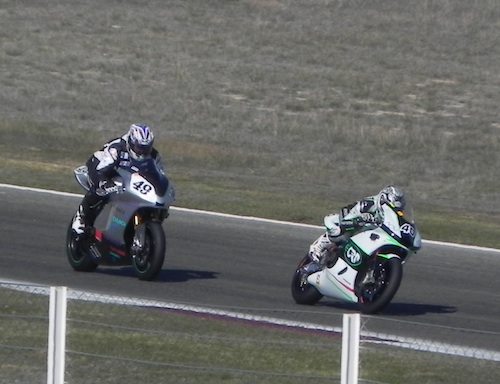 October 24, 2010, TTXGP held the 2010 World Championship at Albacete Spain
October 24, 2010, TTXGP held the 2010 World Championship at Albacete Spain![]() . The race saw a closely fought battle between Meunch Racing and eCRP and Team Agni and Campus Francorchamps, with Meunch Racing winning. I attended
. The race saw a closely fought battle between Meunch Racing and eCRP and Team Agni and Campus Francorchamps, with Meunch Racing winning. I attended![]() and wrote several
and wrote several![]() reports
reports![]() during the weekend.
during the weekend.
Team Agni had two riders – Rob Moon and Jenny Tinmouth. For Jenny’s bike, they replaced the normal twin Agni 95-R’s with a larger Agni motor that had been long promised. The goal was to give her more power but her lap times dropped off during the race and it didn’t perform as expected.
The Campus Francorchamps bike had a problem with one of the motors, and the team cut those wires so he could finish the race on one motor.
The only non-European team was Werkstatt Racing from San Francisco. Werkstatt is a motorcycle repair shop owned by Jennifer Bromme, and she races as a one-person team. Bromme had met Azhar Hussain in January 2010 when he spoke about the TTXGP at the Motorcycle club in San Francisco.
Following the 2010 North America series, the TTXGP made an offer to all the teams to ship their bikes to Europe for the grand final. Only Werkstatt took them up on this offer. Werkstatt was racing a Mavizen TTX02 (which in any case belonged to Mavizen), which TTXGP/Mavizen had shipped to a motorcycle show in Germany before shipping it to Albacete for the race. Jennifer Bromme (who is German herself) also went to Germany for that show.
I believe Agni Motors shipped their bike separately. Lightning Motorcycles wanted to set the land speed record at Bonneville, making it impossible to take TTXGP up on the offer to ship their motorcycle to Europe.
November 7, 2010, Mission Motors announced a shift in strategy![]() . Initially their goal, when Forest North was the CEO, was to become the Tesla of Electric Motorcycles. To that end they built an ultra high-end electric motorcycle, the Mission One, and achieved great results with it (even though Lightning Motorcycles surpassed all of Missions land speed records). However, with Jit Bhattacharya as the CEO, the company wanted to focus instead on designing and selling electric drive train components. Earlier in the year Mission had nearly collapsed, and the Board pushed out Forest North replacing him with Bhattacharya.
. Initially their goal, when Forest North was the CEO, was to become the Tesla of Electric Motorcycles. To that end they built an ultra high-end electric motorcycle, the Mission One, and achieved great results with it (even though Lightning Motorcycles surpassed all of Missions land speed records). However, with Jit Bhattacharya as the CEO, the company wanted to focus instead on designing and selling electric drive train components. Earlier in the year Mission had nearly collapsed, and the Board pushed out Forest North replacing him with Bhattacharya.
November 10, 2010, Chip Yates suddenly pulls out of the TTXGP complaining about rules changes![]() . All through 2010, Yates had been working on building the motorcycle he showed in San Jose in early October. On October 19, the TTXGP issued rules for the 2011 season which made it impossible for Yates to participate. The issue was the upper weight limit, and Yates’ bike was about 35 lbs too heavy. It had been fine under the previous weight limit, but was too heavy under the new limit.
. All through 2010, Yates had been working on building the motorcycle he showed in San Jose in early October. On October 19, the TTXGP issued rules for the 2011 season which made it impossible for Yates to participate. The issue was the upper weight limit, and Yates’ bike was about 35 lbs too heavy. It had been fine under the previous weight limit, but was too heavy under the new limit.
The “Formula GP” class was limited to 250 kilograms weight (551 lbs; lowered from 300 kilograms), and the “Formula 75” class was limited to a 7.5 kilowatt-hour battery pack and 200 kilograms weight.
In his press release, Chip Yates said: “The TTXGP officials knew our bike weight and made this surprise rule change anyway. I contacted them to protest, and they could not provide a single reason why they lowered the weight and they told me that it would not affect any of their current competitors except me. We have to conclude then, that the TTXGP series is catering towards manufactured electric bikes in the scooter category putting out between 50-90 horsepower. No race fan would confuse these with a legitimate superbike, which is what we are developing to give people something to get excited about. Too many electric vehicles are slow and boring, and perpetuate the myth that electric vehicles can’t be powerful and exciting. Our 194 horsepower, liquid-cooled UQM Technologies electric motor makes 295 ft/lbs of torque the instant you open the throttle and can be seen smoking its tire at www.youtube.com/chipyates”. He also repeated allegations about conflicts of interest due to Azhar Hussain owning both TTXGP and Mavizen.
TTXGP’s response was they were disappointed by Chip Yates’ decision, but that they claim to have consulted all the teams about rules changes.
During that time period the eGrandPrix.com website was running banner advertising for Mavizen. At the time I saw that as symptomatic of the potential conflict of interest. Hussain continually claimed that the organizations were operating at arms length from one another and therefore no conflict of interest existed.
Yates’ complaint that TTXGP was “catering towards .. bikes in the scooter category” refers to the fact that most of the bikes had a 100-130 miles/hr top speed. That speed appears excruciatingly slow when raced against superbikes capable of 150-180 miles/hr top speed (or more). The primary symptom is, as mentioned earlier, Lightning’s motorcycle routinely lapped the whole field at least once in every race. It not only makes the slower bikes look bad by comparison, it’s a safety risk because of the vast gulf of speed difference.
November 29, 2010, the Isle of Man announced dates for the 2011 TT ZERO![]() . As has been the case since TT ZERO was launched, its race is held in the middle of TT Week at the end of Wednesday. While it means TT ZERO does get to run, it occurs at a time when few people are paying attention, which limits press coverage.
. As has been the case since TT ZERO was launched, its race is held in the middle of TT Week at the end of Wednesday. While it means TT ZERO does get to run, it occurs at a time when few people are paying attention, which limits press coverage.
December 10, 2010, Chip Yates announced he would race in the WERA club racing series![]() , reiterating claims that TTXGP had excluded him from participating in that series.
, reiterating claims that TTXGP had excluded him from participating in that series.
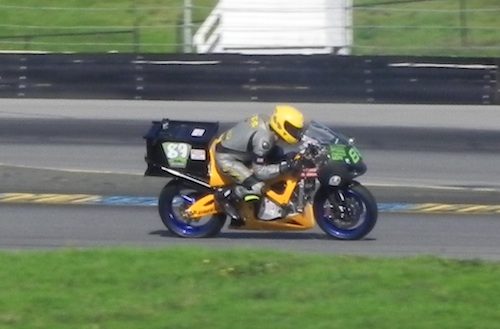 December 15, 2010, Chip Yates took his bike to Infineon Raceway (now called Sonoma Raceway) for a track day to test the bike
December 15, 2010, Chip Yates took his bike to Infineon Raceway (now called Sonoma Raceway) for a track day to test the bike![]() . It was just him on the track, but I was able to observe as part of a small press contingent. It was the first time the bike had been ridden more than around a parking lot. The battery pack, which was in its first charge cycle, was mounted in a large box on the tail which resembled the box used for motorcycle based pizza delivery. The mechanical KERS wasn’t installed — because it wasn’t required for the upcoming WERA race. While he was a little slow through the corners, on the straights he was hitting 140+ miles/hr with the throttle going to about 70% maximum. He was frequently popping little wheelies.
. It was just him on the track, but I was able to observe as part of a small press contingent. It was the first time the bike had been ridden more than around a parking lot. The battery pack, which was in its first charge cycle, was mounted in a large box on the tail which resembled the box used for motorcycle based pizza delivery. The mechanical KERS wasn’t installed — because it wasn’t required for the upcoming WERA race. While he was a little slow through the corners, on the straights he was hitting 140+ miles/hr with the throttle going to about 70% maximum. He was frequently popping little wheelies.
December 18, 2010, Mission Motors revealed the Mission R electric superbike![]() . Previously they had shown the MissonOne, but the Mission R was a very different design. Such as the battery pack being an integral part of the frame. However, nothing was shown on the site for purchasing this bike, and in the ensuing years it was clear Mission Motors saw the Mission R as a vehicle on which to prototype electric vehicle drive train components, not a product in its own right. I wrote a post the next day attempting to compare the Mission R (by its specs) against other top end electric motorcycles
. Previously they had shown the MissonOne, but the Mission R was a very different design. Such as the battery pack being an integral part of the frame. However, nothing was shown on the site for purchasing this bike, and in the ensuing years it was clear Mission Motors saw the Mission R as a vehicle on which to prototype electric vehicle drive train components, not a product in its own right. I wrote a post the next day attempting to compare the Mission R (by its specs) against other top end electric motorcycles![]() .
.
December 23, 2010, TTXGP announced a partnership with Australia’s FX Superbike Championship![]() . This launched the eFX series which gave the Aussie electric motorcycle guys a series to race in. They’ve since had 3+ seasons of racing action and their own electric motorcycle racing journey that was loosely associated with the TTXGP. The practical impact is that TTXGP was now operating on three continents.
. This launched the eFX series which gave the Aussie electric motorcycle guys a series to race in. They’ve since had 3+ seasons of racing action and their own electric motorcycle racing journey that was loosely associated with the TTXGP. The practical impact is that TTXGP was now operating on three continents.
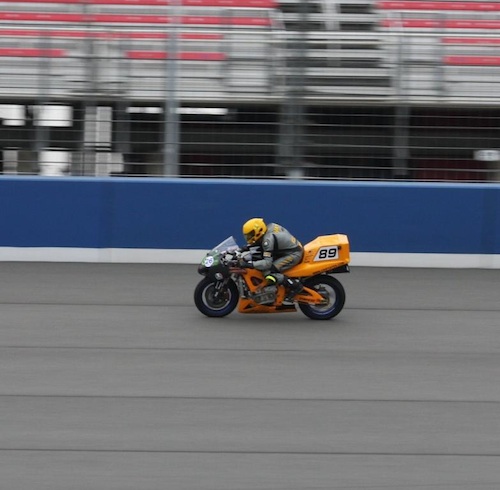 January 9, 2011, Chip Yates races in a WERA event taking the podium
January 9, 2011, Chip Yates races in a WERA event taking the podium![]() while racing against guys on bikes like the Ducati 1000 or Suzuki SV 650. They’d relocated part of the pack into the center of the bike, improving weight balance. The race consumed 27 amp-hours out of a 30 amp-hour pack, for a 6 lap race. That mechanical KERS system may have helped with energy consumption.
while racing against guys on bikes like the Ducati 1000 or Suzuki SV 650. They’d relocated part of the pack into the center of the bike, improving weight balance. The race consumed 27 amp-hours out of a 30 amp-hour pack, for a 6 lap race. That mechanical KERS system may have helped with energy consumption.
April 21, 2011, Mavizen signs a deal with A123 Systems to distribute their AMP20 pouch cells battery pack modules![]() . Mavizen is described as supplying components not only for motorsports uses (like electric motorcycles) but non-automotive and non-motorsports vehicles.
. Mavizen is described as supplying components not only for motorsports uses (like electric motorcycles) but non-automotive and non-motorsports vehicles.
May 8, 2011, A123 Systems sponsored the 2011 North American TTXGP series![]() .
.
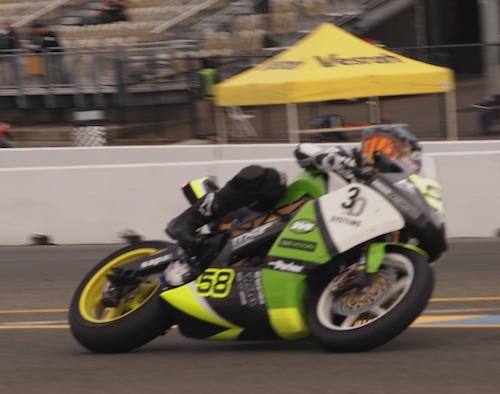 May 15, 2011, TTXGP returns to Infineon Raceway to open its 2011 season
May 15, 2011, TTXGP returns to Infineon Raceway to open its 2011 season![]() . There was a very small number of teams participating – Lightning Motors completely failed to show up. This was Brammo’s first outing for the Empulse, and they easily won since Lightning wasn’t in attendance. There were two classes this year, with the TTX75 bikes limited to 7.5 kiloWatt-hours of capacity. Team Electra came with a brand new bike – instead of the vintage Norton Featherbed frame, they’d had a replica of that frame built and then installed the electric drive train on that bike.
. There was a very small number of teams participating – Lightning Motors completely failed to show up. This was Brammo’s first outing for the Empulse, and they easily won since Lightning wasn’t in attendance. There were two classes this year, with the TTX75 bikes limited to 7.5 kiloWatt-hours of capacity. Team Electra came with a brand new bike – instead of the vintage Norton Featherbed frame, they’d had a replica of that frame built and then installed the electric drive train on that bike.
Steve Atlas, riding the Brammo Empulse RR, set a new lap record at Infineon for electric motorcycle![]() s – 1:55.
s – 1:55.
Both Lightning and Mission Motors had been expected to race in this event![]() . Lightning was going to bring two bikes, one (#80) ridden by Michael Barnes, the other (#88) ridden by Michael Hannas who’d ridden with the ElectricRaceBikes.com team the previous year.
. Lightning was going to bring two bikes, one (#80) ridden by Michael Barnes, the other (#88) ridden by Michael Hannas who’d ridden with the ElectricRaceBikes.com team the previous year.
June 9, 2011, MotoCzysz wins the TT ZERO for the second year running![]() . Lightning Motorcycle was there (which may have been the reason to skip the TTXGP season opener) but they did not finish the race. MotoCzysz had two bikes in the race, with Mike Rutter finishing with the fastest lap time of 99.604 miles/hr or just shy of breaking the ton.
. Lightning Motorcycle was there (which may have been the reason to skip the TTXGP season opener) but they did not finish the race. MotoCzysz had two bikes in the race, with Mike Rutter finishing with the fastest lap time of 99.604 miles/hr or just shy of breaking the ton.
June 27, 2011, at the 2011 REFUEL Race there was a fortuitous occurrence in which both Brammo and Mission Motors attended![]() . The yearly REFUEL series is primarily an opportunity for electric car owners to get some track time, but in 2011 it also served as a preview of the 2011 FIM e-Power race scheduled for July.
. The yearly REFUEL series is primarily an opportunity for electric car owners to get some track time, but in 2011 it also served as a preview of the 2011 FIM e-Power race scheduled for July.
July 24, 2011, Brammo and TTXGP announced a joint partnership in which Brammo would supply TTXGP-ready versions of the Empulse for teams to use in racing![]() . Brammo’s plan was to use the Empulse RR as an ultra high-end electric motorcycle for prototyping, and to sell the Empulse R as a regular street bike with more modest performance. The Empulse TTX would be an Empulse R modified to fit TTXGP racing rules.
. Brammo’s plan was to use the Empulse RR as an ultra high-end electric motorcycle for prototyping, and to sell the Empulse R as a regular street bike with more modest performance. The Empulse TTX would be an Empulse R modified to fit TTXGP racing rules.
The announcement was released on the morning of the Saturday of the Laguna Seca MotoGP (and FIM e-Power) event. I read that press release just before heading to the track, and upon arriving at the track began asking around to see what the other participants thought of the plan. I’d expected that they would have heard of the plan, that the TTXGP would have given a heads-up to all the teams. Instead it was new information to every participant, some of whom had their own plans to sell electric motorcycles.
In other words, with this plan TTXGP was going into competition with teams who were participating in the series.
For example, eCRP had flown from Europe to participate in the race, and by this time had announced plans to lease bikes out to race teams. Following the 2011 season they did not return to any racing competition, but held a few events of their own making. It wasn’t until 2014 that CRP’s motorcycle effort became the Energica Superbike.
Likewise, Lightning Motors, Mission Motors, and Muench Racing had also discussed the possibility of selling electric motorcycles suitable for racing.
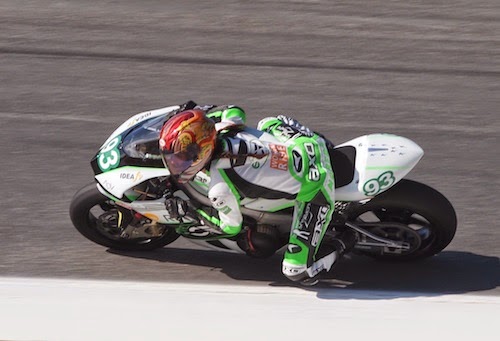 Misssion Motors won the 2011 FIM e-Power/TTXGP event, by a long distance
Misssion Motors won the 2011 FIM e-Power/TTXGP event, by a long distance![]() . They had top racer Steve Rapp riding. He delivered a blistering performance, setting a 1:31 lap time record, in practice, at Laguna Seca that’s still standing today (I believe). The 1:33 lap times he delivered during the race have been beaten since. This was fast enough to qualified mid-pack for the AMA Superbike race held the same weekend, and was a few seconds shy of the MotoGP lap time. I wrote up a second post with detailed results
. They had top racer Steve Rapp riding. He delivered a blistering performance, setting a 1:31 lap time record, in practice, at Laguna Seca that’s still standing today (I believe). The 1:33 lap times he delivered during the race have been beaten since. This was fast enough to qualified mid-pack for the AMA Superbike race held the same weekend, and was a few seconds shy of the MotoGP lap time. I wrote up a second post with detailed results![]() .
.
Lightning and MotoCzysz had another of the instances where MotoCzysz beat Lightning by a nose at the finish line.
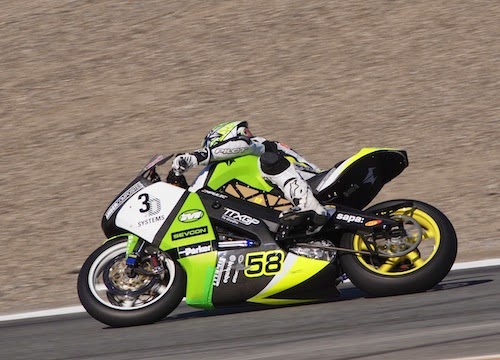 Notice I wrote the event name as “FIM e-Power/TTXGP”. Over the winter there’d been some rapproachment between FIM and TTXGP. They’d decided to jointly run the Laguna Seca event, and perhaps one of the events in Europe. This was meant to be the beginning of a process where the two organizations could somehow join forces. In the 2013 season they did eventually merge, and form the eRoadRacing series.
Notice I wrote the event name as “FIM e-Power/TTXGP”. Over the winter there’d been some rapproachment between FIM and TTXGP. They’d decided to jointly run the Laguna Seca event, and perhaps one of the events in Europe. This was meant to be the beginning of a process where the two organizations could somehow join forces. In the 2013 season they did eventually merge, and form the eRoadRacing series.
July 31, 2011, Lightning Motorcycle and Ener1 sign a deal where Lightning became an Ener1 distributor![]() . One fallout of the deals between A123 Systems and Mavizen and TTXGP (see links above) is that Lightning Motorcycle lost the sponsorship of A123 Systems. Previously A123 had sponsored Lightning, providing battery packs etc. Lightning turned to Ener1 and even today (mid-2015) is still using Ener1 cells.
. One fallout of the deals between A123 Systems and Mavizen and TTXGP (see links above) is that Lightning Motorcycle lost the sponsorship of A123 Systems. Previously A123 had sponsored Lightning, providing battery packs etc. Lightning turned to Ener1 and even today (mid-2015) is still using Ener1 cells.
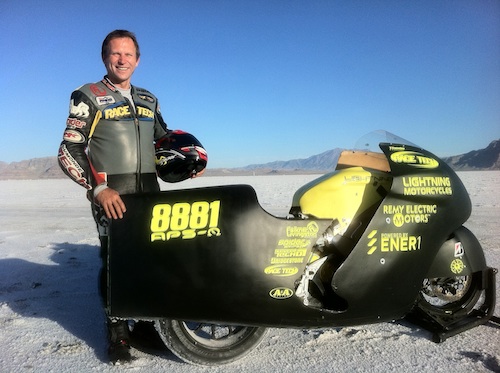 August 15, 2011, Lightning Motorcyle returns to Bonneville Salt Flats to set 215 miles/hr land speed record for electric motorcycles
August 15, 2011, Lightning Motorcyle returns to Bonneville Salt Flats to set 215 miles/hr land speed record for electric motorcycles![]() . That record still stands today. The top speed reached that week was 218 miles/hr, giving Lightning the model name for the bike they’re now (in 2015) selling – the LS-218.
. That record still stands today. The top speed reached that week was 218 miles/hr, giving Lightning the model name for the bike they’re now (in 2015) selling – the LS-218.
August 25, 2011, Mavizen announces that Bill Dube joined the company as CTO![]() . Dube’s claim to fame is the KillaCycle electric drag bike famously powered with A123 Systems cells. He and his wife, Eva, have built and raced an electric three-wheeler streamliner motorcycle, the KillaJoule, at Bonnevile for several seasons now, with 2011 being its first season.
. Dube’s claim to fame is the KillaCycle electric drag bike famously powered with A123 Systems cells. He and his wife, Eva, have built and raced an electric three-wheeler streamliner motorcycle, the KillaJoule, at Bonnevile for several seasons now, with 2011 being its first season.
Part of signing Bill Dube as the CTO![]() , Mavizen announced a change in focus to work on projects like the Quimera AEGT01. That car was built by a Spanish clean energy consortium and was billed as the most powerful electric car anywhere.
, Mavizen announced a change in focus to work on projects like the Quimera AEGT01. That car was built by a Spanish clean energy consortium and was billed as the most powerful electric car anywhere.
September 2, 2011, more electric motorcycle land speed action occurred at Bonneville![]() . The KillaJoule team unfortunately blew their controller and wasn’t able to do more than 138 miles/hr. That was enough to set a record in their class, and to make Bill and Eva fall in love with racing on the salt flats and they’ve come back every year since.
. The KillaJoule team unfortunately blew their controller and wasn’t able to do more than 138 miles/hr. That was enough to set a record in their class, and to make Bill and Eva fall in love with racing on the salt flats and they’ve come back every year since.
Chip Yates had skipped a bunch of WERA races, not following through with his promise to race the whole WERA season. He came to Bonneville with the goal of setting land speed records. There’s an important distinction between the event Yates attended, and the one Lightning attended two weeks earlier. The BUB Motorcycle Speed Trials are certified by the FIM, and the records set by Yates at BUB were therefore FIM and AMA land speed records. The event Lightning attended was not certified that way, and while Lightning’s speed was faster than Yates, it is Yates name that is in the FIM record books.
Yates’ records were just shy of 200 miles/hr. He set four different records by running the bike with, and with-out fairings, and then by stripping off a few components to lower the bikes race and running in another weight class.
Lightning wasn’t able to participate in the 2011 BUB Motorcycle Speed Trials![]() because they were due to race in the TTXGP North American final at Miller Motorsports Park outside Salt Lake City.
because they were due to race in the TTXGP North American final at Miller Motorsports Park outside Salt Lake City.
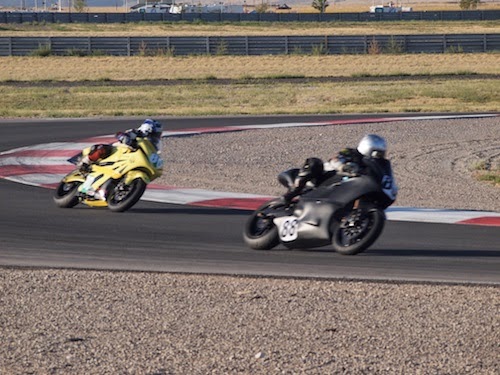 September 4, 2011, as just mentioned the 2011 North American Final was held at Miller Motorsports
September 4, 2011, as just mentioned the 2011 North American Final was held at Miller Motorsports![]() . This was another instance where MotoCzysz beat Lightning, and both beat Brammo. However, Brammo won the North American championship.
. This was another instance where MotoCzysz beat Lightning, and both beat Brammo. However, Brammo won the North American championship.
Lightning, having had to drive back to the Bay Area after the Bonneville event to clean and reconfigure their bikes, made it to the race track very late on Saturday. They were so late that Lightning completely missed the qualifying races. They did bring two bikes, the #80 and #88 mentioned earlier. However, instead of Barnes and Hannas they had Ted Rich and Tim Hunt riding. Shane Turpin was riding for MotoCzysz, Steve Atlas riding for Brammo and Thadd Wolf riding for Team Electra.
Turpin (MotoCzysz) simply pulled ahead of Lightning’s bikes and kept going. Because Lightning had missed the qualifying, they were put at the back of the grid. Both their riders attempted to pass the entire pack off the line, and that maneuver almost worked. Halfway through the race Ted Rich’s bike suffered a broken chain, putting him out of the race.
Brammo won the championship because of having earned points over the whole season.
The reader may note that the 2011 season only featured three TTXGP events in North America. Only one, the season opener at Infineon, was at an AMA event. The other two were either at MotoGP or AHRMA events – the Miller Motorsport event was held alongside an AHRMA race. I’ve since heard that the AMA was pissed off at TTXGP from the 2010 season, and refused to work with TTXGP.
September 24, 2011, Matthias Himmelman won the 2011 TTXGP Europe championship![]() . He handily beat both CRP and Zongshen, finishing at least a half minute ahead of them. This race is one of the times American rider Shelina Moreda raced with CRP. She’d joined them for the 2011 Laguna Seca event as their second rider, then joined them in Europe for a few months.
. He handily beat both CRP and Zongshen, finishing at least a half minute ahead of them. This race is one of the times American rider Shelina Moreda raced with CRP. She’d joined them for the 2011 Laguna Seca event as their second rider, then joined them in Europe for a few months.
What’s more important is that this event was jointly held by FIM e-Power and TTXGP, at the 24 Hours of Le Mans Endurance race. It was the second time e-Power and TTXGP worked together.
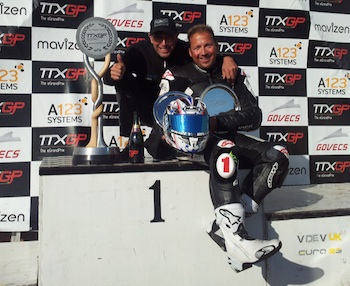 October 16, 2011, The TTXGP World Championship was very lightly attended
October 16, 2011, The TTXGP World Championship was very lightly attended![]() . During 2011, the TTXGP was plagued with difficulty setting up the race schedule. The final race in particular was never announced until October, giving teams five days in which to scramble to attend the event – which was in Wales. Matthias Himmelman won the championship
. During 2011, the TTXGP was plagued with difficulty setting up the race schedule. The final race in particular was never announced until October, giving teams five days in which to scramble to attend the event – which was in Wales. Matthias Himmelman won the championship![]() , but one wonders what the result would have been if teams from other continents could have taken part. On October 10, CATAVOLT had won the Australian series
, but one wonders what the result would have been if teams from other continents could have taken part. On October 10, CATAVOLT had won the Australian series![]() . In theory they were then supposed to pack up their bike, and immediately head to Wales for a world championship race. That would have been impossible.
. In theory they were then supposed to pack up their bike, and immediately head to Wales for a world championship race. That would have been impossible.
December 21, 2011, TTXGP signs multi-year deal with Assen to hold races at that venue![]() . This is a historic race track in the Netherlands.
. This is a historic race track in the Netherlands.
February 15, 2012, TTXGP and UEM (the European Federation of the FIM) announced a partnership for electric motorcycle racing in Europe![]() . While TTXGP and the FIM had been fighting, TTXGP was able to strike this deal with a continent-level FIM-affiliated group.
. While TTXGP and the FIM had been fighting, TTXGP was able to strike this deal with a continent-level FIM-affiliated group.
TTXGP releases 2012 schedule for the 2012 TTXGP/eFXC season![]() . There are several TBD’s in the schedule, meaning the it wasn’t a set-in-stone schedule. The 2012 World Final was to be held outside Europe for the first time, at the the Daytona International Raceway, alongside the AHRMA event. The North America schedule also marked a return to Miller Motorsports and the AHRMA event over Labor Day weekend.
. There are several TBD’s in the schedule, meaning the it wasn’t a set-in-stone schedule. The 2012 World Final was to be held outside Europe for the first time, at the the Daytona International Raceway, alongside the AHRMA event. The North America schedule also marked a return to Miller Motorsports and the AHRMA event over Labor Day weekend.
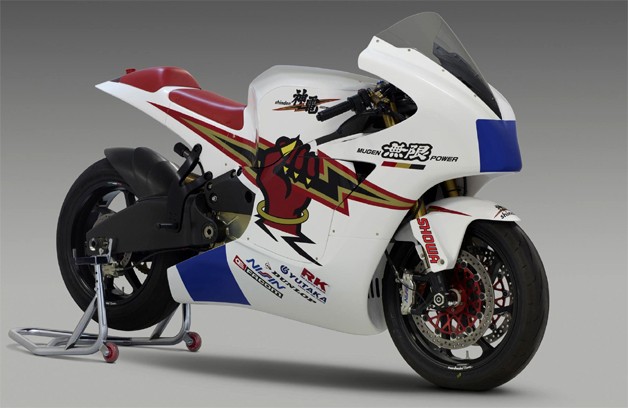 February 16, 2012, Mugen (a.k.a. Honda) announces they’d be entering the 2012 TT ZERO
February 16, 2012, Mugen (a.k.a. Honda) announces they’d be entering the 2012 TT ZERO![]() . Mugen has been saying they’re Mugen, not Honda, but it’s widely thought that in this case Mugen is acting as a front for Honda’s early development of electric superbikes. Honda of course is one of the top companies in motorcycling, so it would be a huge step for electric motorcycles if Honda were to launch an electric superbike.
. Mugen has been saying they’re Mugen, not Honda, but it’s widely thought that in this case Mugen is acting as a front for Honda’s early development of electric superbikes. Honda of course is one of the top companies in motorcycling, so it would be a huge step for electric motorcycles if Honda were to launch an electric superbike.
Shinden is apparently the Japanese God of Lightning – very fitting name for an electric motorcycle, and makes for some really cool graphics.
February 17, 2012, Brammo announces intent to race the entire 2012 TTXGP season including the 2012 Final, that was to be held at Daytona Beach![]() .
.
April 26, 2012, the Aussie TTXGP/eFXC season opened![]() . Meunch Racing won at the FIM e-Power event at Mangy Cours
. Meunch Racing won at the FIM e-Power event at Mangy Cours![]() .
.
FIM and TTXGP announced they’d hold three joint events during 2012![]() , the Laguna Seca MotoGP, at Oschersleben in mid-August at the FIM Endurance World Cup, and in September at the FIM 24 Hours of Le Mans Endurance race.
, the Laguna Seca MotoGP, at Oschersleben in mid-August at the FIM Endurance World Cup, and in September at the FIM 24 Hours of Le Mans Endurance race.
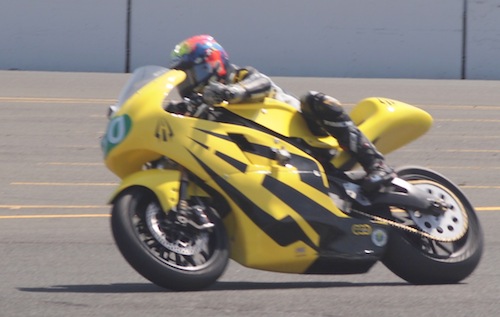 May 11, 2012, the 2012 North America TTXGP season opened at Infineon Raceway
May 11, 2012, the 2012 North America TTXGP season opened at Infineon Raceway![]() , with snafus galore. Brammo participated but Steve Atlas crashed out, breaking a vertebrae, and then Steve Rapp was called in to replace him and he crashed as well. Lightning Motorcycles won the two races held that weekend, but lost to Zero on points. What happened is the race was split into two races, and Lightning had two bikes. Each of their bikes broke down during one of the races, while the bikes fielded by Zero Motorcycle made it through both races. That gave Zero more points and the win for the weekend.
, with snafus galore. Brammo participated but Steve Atlas crashed out, breaking a vertebrae, and then Steve Rapp was called in to replace him and he crashed as well. Lightning Motorcycles won the two races held that weekend, but lost to Zero on points. What happened is the race was split into two races, and Lightning had two bikes. Each of their bikes broke down during one of the races, while the bikes fielded by Zero Motorcycle made it through both races. That gave Zero more points and the win for the weekend.
This turned into a serious fight between Lightning and TTXGP, most of which I cannot relate.
May 23, 2012, TTXGP Europe 2012 season opener held in Sweden![]() . Himmelmann handily beat everyone, lapping the whole field.
. Himmelmann handily beat everyone, lapping the whole field.
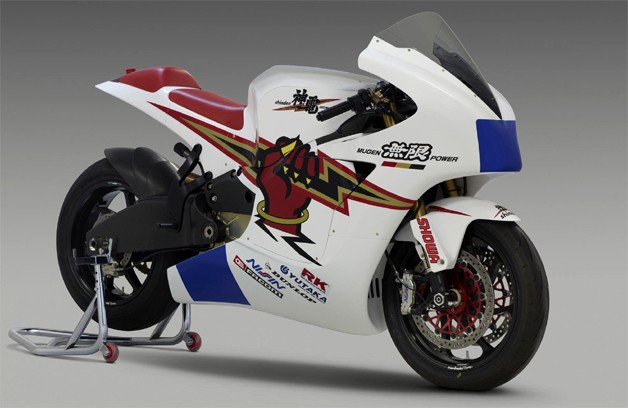 June 7, 2012, MotoCzysz not only beats Mugen (after Mugen spent $millions on developing the bike) but they broke the ton
June 7, 2012, MotoCzysz not only beats Mugen (after Mugen spent $millions on developing the bike) but they broke the ton![]() . This phrase, “break the ton”, refers to finishing with a 100+ miles/hr lap speed record. The Isle of Man Government had a prize waiting for the first TT ZERO team to do so, and it took MotoCzysz two years to grab that prize.
. This phrase, “break the ton”, refers to finishing with a 100+ miles/hr lap speed record. The Isle of Man Government had a prize waiting for the first TT ZERO team to do so, and it took MotoCzysz two years to grab that prize.
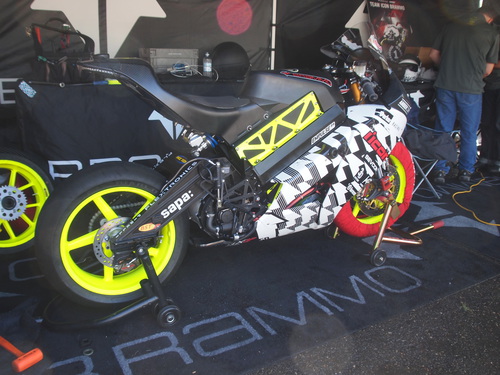 June 24, 2012, Brammo wins the TTXGP at Portland International Raceway
June 24, 2012, Brammo wins the TTXGP at Portland International Raceway![]() after MotoCzysz pulls out after one of their bikes nearly caught fire during practice
after MotoCzysz pulls out after one of their bikes nearly caught fire during practice![]() . Lightning Motorcycles simply did not attend this event. For MotoCzysz, their bikes had just returned from the Isle of Man on Friday just before the race began on Saturday. That meant they’d been unable to reconfigure the bikes from the energy cells used for the Isle of Man to the power cells suitable to the TTXGP. Immediately following a practice round, one of MotoCzysz’s riders pulled into the pit with the bike smoking, and to prevent a fire they had to douse it with water. By the next morning MotoCzysz’s pit area was empty. That left Brammo’s Steve Atlas without competition and he handily won.
. Lightning Motorcycles simply did not attend this event. For MotoCzysz, their bikes had just returned from the Isle of Man on Friday just before the race began on Saturday. That meant they’d been unable to reconfigure the bikes from the energy cells used for the Isle of Man to the power cells suitable to the TTXGP. Immediately following a practice round, one of MotoCzysz’s riders pulled into the pit with the bike smoking, and to prevent a fire they had to douse it with water. By the next morning MotoCzysz’s pit area was empty. That left Brammo’s Steve Atlas without competition and he handily won.
In any case that left Brammo as the only top end bike present, so of course they won whereas if MotoCzysz had managed to stay for the weekend there’d have been a contest.
July 12, 2012, Himmelmann won the 2nd round of TTXGP Europe at Snetterton![]() .
.
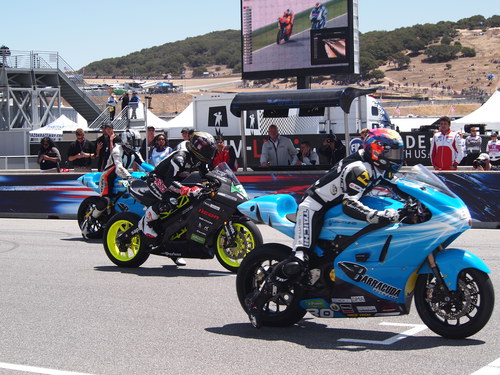 July 24, 2012, the FIM e-Power/TTXGP returned to Laguna Seca
July 24, 2012, the FIM e-Power/TTXGP returned to Laguna Seca![]() . Lightning won, with Brammo coming in 2nd/3rd. MotoCzysz didn’t participate, meaning we didn’t have another instance of MotoCzysz beating Lightning by a nose. Brammo added a second bike to their lineup, bringing legendary rider Eric Bostrom to the team. There were several entries where Zero Motorcycles supplied modified 2012 Zero S’s to various riders.
. Lightning won, with Brammo coming in 2nd/3rd. MotoCzysz didn’t participate, meaning we didn’t have another instance of MotoCzysz beating Lightning by a nose. Brammo added a second bike to their lineup, bringing legendary rider Eric Bostrom to the team. There were several entries where Zero Motorcycles supplied modified 2012 Zero S’s to various riders.
 September 2, 2012, Brammo won the TTXGP North America championship
September 2, 2012, Brammo won the TTXGP North America championship![]() . There’d been no real competition for them because none of the major North American competitors (Lightning, MotoCzysz) showed up.
. There’d been no real competition for them because none of the major North American competitors (Lightning, MotoCzysz) showed up.
September 2012, Lightning Motors travels to Europe to take part in the FIM e-Power/TTXGP Le Mans event![]() . They won the race, but Meunch Racing (Matthias Himmelman) won the TTXGP Europe championship. They had hired Miguel Duhamel as their rider
. They won the race, but Meunch Racing (Matthias Himmelman) won the TTXGP Europe championship. They had hired Miguel Duhamel as their rider![]() .
.
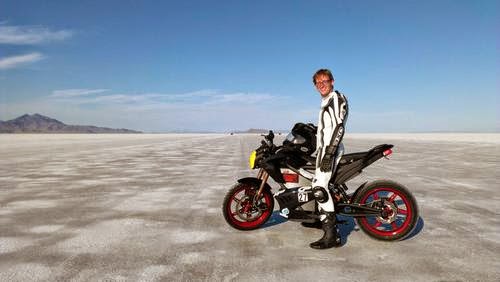 September 20, 2012, Brandon Nozaki-Miller took a lightly modified 2012 Zero S to Bonneville and set a 102 miles/hr land speed record in the lightweight electric motorcycle class
September 20, 2012, Brandon Nozaki-Miller took a lightly modified 2012 Zero S to Bonneville and set a 102 miles/hr land speed record in the lightweight electric motorcycle class![]() . He’s fairly unique among AMA licensed motorcycle racers in that he’s never ridden a gasoline powered motorcycle. His racing career has taken him to tracks up and down California, the Bonneville Salt Flats, and to the Pikes Peak International Hill Climb.
. He’s fairly unique among AMA licensed motorcycle racers in that he’s never ridden a gasoline powered motorcycle. His racing career has taken him to tracks up and down California, the Bonneville Salt Flats, and to the Pikes Peak International Hill Climb.
October 21, 2012, Brammo wins the 2012 TTXGP World Championship![]() . The competition for leadership position was between Brammo and Meunch, because neither Lightning nor MotoCzysz participated. Both of Brammo’s bikes had problems with losing power the whole weekend, but in addition both were hitting 170+ miles/hr speeds in racing competition. Team Catavolt had traveled all the way from Australia, only to have severe motor problems that hampered their speed.
. The competition for leadership position was between Brammo and Meunch, because neither Lightning nor MotoCzysz participated. Both of Brammo’s bikes had problems with losing power the whole weekend, but in addition both were hitting 170+ miles/hr speeds in racing competition. Team Catavolt had traveled all the way from Australia, only to have severe motor problems that hampered their speed.
December 2, 2012, Sonoma Raceway announced that the AMA Superbike event that traditionally happened in May was canceled![]() . This would have affected the usual TTXGP season which saw the season open at that track.
. This would have affected the usual TTXGP season which saw the season open at that track.
December 12, 2012, TTXGP hired a “Chief Commercial Officer” and was looking to hire a Marketing manager![]() . What we didn’t know at the time is they were preparing to switch gears to the eRoadRacing series.
. What we didn’t know at the time is they were preparing to switch gears to the eRoadRacing series.
February 7, 2013, Mugen announces their return to TTZERO![]() .
.
February 11, 2013, Hollywood Electrics announces a new electric motorcycle race series – the M1GP![]() . This series is being held alongside a club racing series in Southern California, and is open to electric motorcycle riders.
. This series is being held alongside a club racing series in Southern California, and is open to electric motorcycle riders.
March 5, 2013, the FIM and TTXGP jointly announce that both the TTXGP and e-Power series were completely canceled and being replaced with a completely new series, eRoadRacing![]() . This had been the subject of negotiation for several years, and it came down to both series having to die in order to create a joint series. The plan was for 2013 the eRoadRacing would have two continent-level series (Europe and North America, leaving Australia to their own devices) and in subsequent years it would change into an international series of top ranking electric superbikes.
. This had been the subject of negotiation for several years, and it came down to both series having to die in order to create a joint series. The plan was for 2013 the eRoadRacing would have two continent-level series (Europe and North America, leaving Australia to their own devices) and in subsequent years it would change into an international series of top ranking electric superbikes.
March 28, 2013, Zero and Hollywood Electrics announced an effort to get a dozen or so electric motorcycles entered in the 2013 Pikes Peak International Hill Climb![]() .
.
June 4, 2013, Carlin Dunne, King of the Pikes Peak race, switched from gas to electric for 2013![]() . This was quite a coup for Lightning Motorcycles, since Dunne owned the outright speed record and had won the event for a couple years running.
. This was quite a coup for Lightning Motorcycles, since Dunne owned the outright speed record and had won the event for a couple years running.
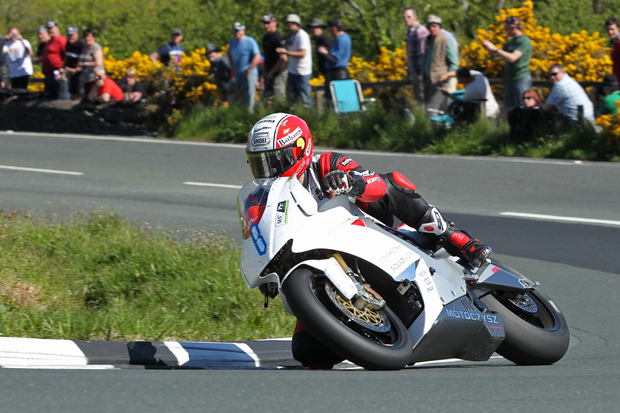
PACEMAKER, BELFAST, 5/6/2013: Michael Rutter (Team Segway Racing MotoCzysz) on his way to victory in the Isle of Man TT Zero Race today. PICTURE BY DAVE KNEEN
June 5, 2013, MotoCzysz beats Mugen at the TT ZERO while Michael Czysz was at home getting cancer treatments![]() . They nearly beat 110 miles/hr even. Mugen and MotoCzysz both had two bikes, but one of the MotoCzysz bikes broke towards the end of the race
. They nearly beat 110 miles/hr even. Mugen and MotoCzysz both had two bikes, but one of the MotoCzysz bikes broke towards the end of the race![]() .
.
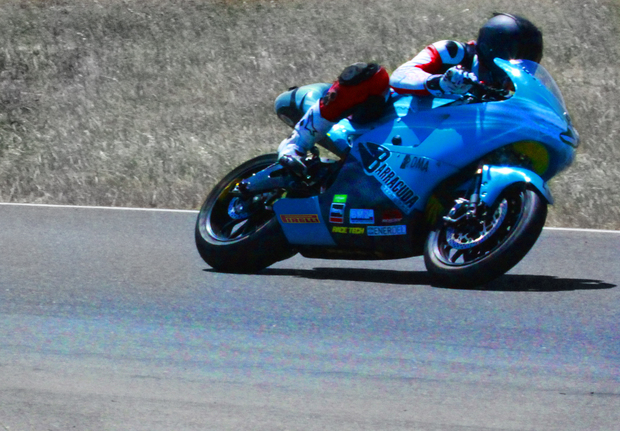 July 2, 2013, Lightning Motorcycles smashes the competition at the 2013 Pikes Peak International Hill Climb
July 2, 2013, Lightning Motorcycles smashes the competition at the 2013 Pikes Peak International Hill Climb![]() . Not only did they have the fastest electric motorcycle, but they had the fastest bike period. Carlin Dunne finished with a 10:00.694 lap time, average speed of 71.917 miles/hr. This was over 20 seconds faster than the next fastest gas bike, and they beat a whole flotilla of the fastest motorcycles on the planet. The electric car racers also did well at Pikes Peak, however the results at that event were completely overshadowed by a complete shocker of a win by Sebastien Loeb whose 8:13 time was about 1 1/2 minutes faster than the next fastest, Rhys Millen who had a 9:46 time.
. Not only did they have the fastest electric motorcycle, but they had the fastest bike period. Carlin Dunne finished with a 10:00.694 lap time, average speed of 71.917 miles/hr. This was over 20 seconds faster than the next fastest gas bike, and they beat a whole flotilla of the fastest motorcycles on the planet. The electric car racers also did well at Pikes Peak, however the results at that event were completely overshadowed by a complete shocker of a win by Sebastien Loeb whose 8:13 time was about 1 1/2 minutes faster than the next fastest, Rhys Millen who had a 9:46 time.
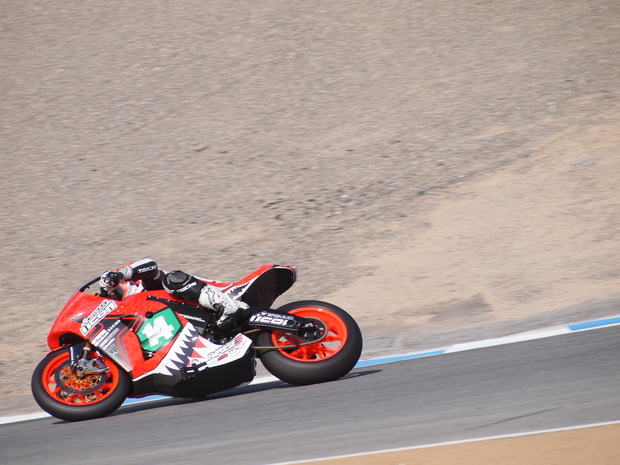
July 21, 2013, after several snafu’s in the race (several riders crashed out), Eric Bostrom (Brammo), Kenyon Kluge (Zero) and Jeremiah Johnson (independent) won the eRoadRacing event at Laguna Seca![]() . For example, Shane Turpin was riding for Brammo, was hitting 140+ miles/hr speeds (that’s fast for Laguna Seca) and even broke the Mission Motors lap speed record with a 1:32 lap speed during the race. But, he was hitting the juice too hard and the bike didn’t finish the race. Between that and several other riders crashing, the results were a little unexpected.
. For example, Shane Turpin was riding for Brammo, was hitting 140+ miles/hr speeds (that’s fast for Laguna Seca) and even broke the Mission Motors lap speed record with a 1:32 lap speed during the race. But, he was hitting the juice too hard and the bike didn’t finish the race. Between that and several other riders crashing, the results were a little unexpected.
August 31, 2013, Lightning Motors went to the BUB Motorcycle Speed Trials and set AMA/FIM land speed records![]() , supplanting the records achieved by Chip Yates in 2011. The new record? 203 miles/hr. KillaCycle Racing got a 213 miles/hr record with the KillaJoule streamliner
, supplanting the records achieved by Chip Yates in 2011. The new record? 203 miles/hr. KillaCycle Racing got a 213 miles/hr record with the KillaJoule streamliner![]() . The event was cut short by an epic rainstorm.
. The event was cut short by an epic rainstorm.
August 18, 2013, Shane Turpin (Brammo) won the eSuperStock at the Indianapolis Speedway (during MotoGP weekend there)![]() . This was the first North America electric motorcycle race event I’d personally missed since 2009. It was the first electric vehicle race ever held in Indianapolis. I wrote up an analysis of how the Zero S’s were outperforming the Empulse TTX, for less money
. This was the first North America electric motorcycle race event I’d personally missed since 2009. It was the first electric vehicle race ever held in Indianapolis. I wrote up an analysis of how the Zero S’s were outperforming the Empulse TTX, for less money![]() . Then both Brian Wisman
. Then both Brian Wisman![]() and Kenyon Kluge
and Kenyon Kluge![]() wrote up observations (on Facebook, which I summarized) about factors in this race.
wrote up observations (on Facebook, which I summarized) about factors in this race.
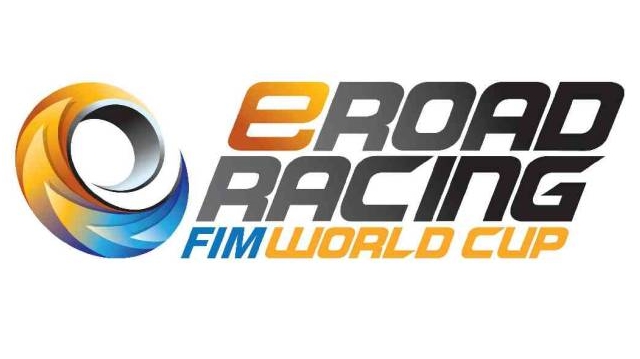 November 18, 2013, the eRoadRacing team quietly closed out the 2013 season without holding any kind of final race
November 18, 2013, the eRoadRacing team quietly closed out the 2013 season without holding any kind of final race![]() . They simply announced that Zongshen’s Ho Chi Fung had won the eRoadRacing Europe championship, while Brammo’s Eric Bostrom won it in North America. That’s it, no fanfare, just a quiet press release. A few days later Asphalt and Rubber wrote that the eRoadRacing series was “foundering”
. They simply announced that Zongshen’s Ho Chi Fung had won the eRoadRacing Europe championship, while Brammo’s Eric Bostrom won it in North America. That’s it, no fanfare, just a quiet press release. A few days later Asphalt and Rubber wrote that the eRoadRacing series was “foundering”![]() (as in a ship that had struck rocks and was sinking).
(as in a ship that had struck rocks and was sinking).
That was it for the TTXGP – a quiet fizzle into nothingness in late 2013.
The TTXGP was survived by TT ZERO.
Zero Motorcycles’ staff spent several years testing and refining their motorcycles through racing events. This wasn’t an official project by the company, but instead was the staff spending their own time and money, using equipment borrowed from the company, with the company giving a wink & nod to their employees racing activities. For example, Kenyon Kluge, who is a top electrical engineer at Zero, also holds an AMA racing license and he was the team captain (more or less) at several events.
Brammo made their name at the 2009 TTXGP, and then starting with the 2011 season a string of wins and championship titles. The company recently sold the motorcycle manufacturing assets to Polaris, and it seems Polaris will integrate the technology into the Victory motorcycle brand.
Lightning Motorcycles launched sales of the LS-218 in the Fall of 2014. This is a duplicate of the race bike which won Pikes Peak and set the land speed record. The company plans to offer a line of other more sedate electric motorcycles, in time, and see’s the LS-218 as the same sort of launchpad that the Roadster was for Tesla Motors.
In Europe, two companies (Sarolea and Bultalco) have started up in Electric Motorcycles, using the TT ZERO series as their testing ground.
Honda is strongly likely using Mugen to develop electric motorcycle technology, and in a few years we should see them begin selling electric bikes.
The same sort of technology advances allowing GM and Nissan and Ford and Tesla Motors to announce 200+ mile range electric cars in 2017 will allow electric motorcycles to have even more speed and range than now. By 2013-2014 the top electric motorcycles were matching 600cc superbike and even MotoGP speeds, but they couldn’t offer enough range to finish a typical professional motorcycle race. But a battery energy density breakthrough allowing 30 kiloWatt-hours on an electric motorcycle could produce that combination.
- Is there enough Grid Capacity for Hydrogen Fuel Cell or Battery Electric cars? - April 23, 2023
- Is Tesla finagling to grab federal NEVI dollars for Supercharger network? - November 15, 2022
- Tesla announces the North American Charging Standard charging connector - November 11, 2022
- Lightning Motorcycles adopts Silicon battery, 5 minute charge time gives 135 miles range - November 9, 2022
- Tesla Autopilot under US Dept of Transportation scrutiny - June 13, 2022
- Spectacular CNG bus fire misrepresented as EV bus fire - April 21, 2022
- Moldova, Ukraine, Georgia, Russia, and the European Energy Crisis - December 21, 2021
- Li-Bridge leading the USA across lithium battery chasm - October 29, 2021
- USA increasing domestic lithium battery research and manufacturing - October 28, 2021
- Electrify America building USA/Canada-wide EV charging network - October 27, 2021









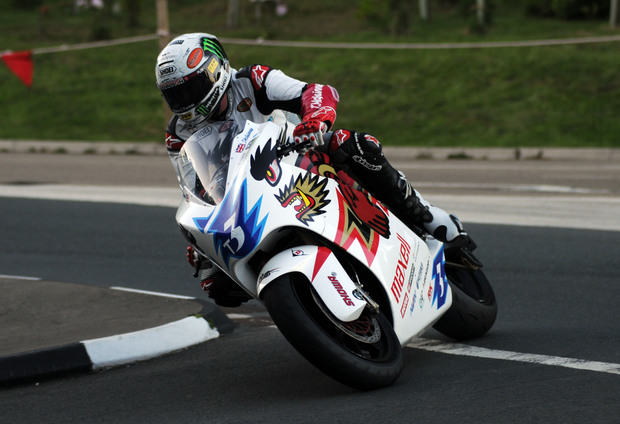













Pingback: The Complete TTXGP Summary
Pingback: The TTXGP Electric Motorcycle Racing series is dead, why is it still important? | The Long Tail Pipe
Pingback: Victory Motorcycles reworks Brammo’s Empulse RR’s for TT ZERO | The Long Tail Pipe
Pingback: McGuinness and Anstey nearly break 120 miles/hr at 2015 TT ZERO, Victory has great first outing | The Long Tail Pipe
Pingback: Solar powered racing to educate high school students about solar power, electric vehicles and engineering | The Long Tail Pipe
Pingback: Is the REFUEL event at risk if Monterey County changes Laguna Seca management agreement? | The Long Tail Pipe